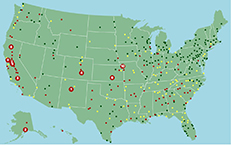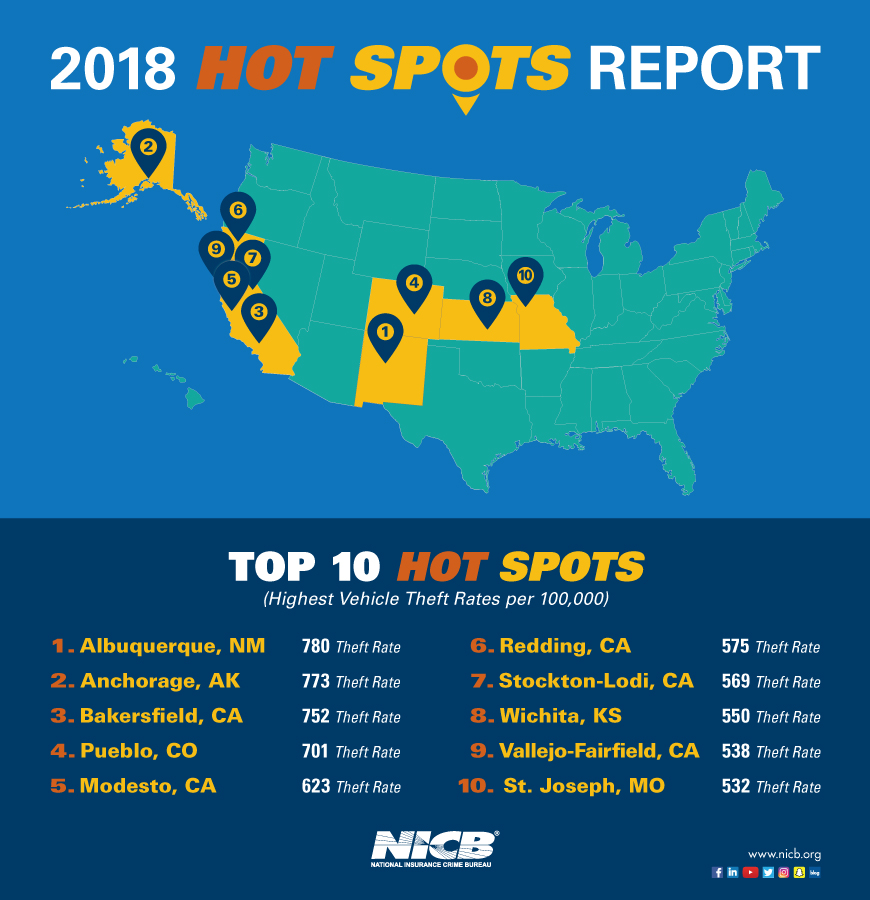2018 Hot Spots
National Map | Top 10 | By Rank | By State | Video | Infographic | Methodology
Numbers signal resumption of downward trend
DES PLAINES, Ill., June 25, 2019 — After adopting effective programs to reduce the vehicle theft problem in the Albuquerque, N.M. metropolitan statistical area (MSA), including the creation of a statewide Auto Theft Prevention Authority, much success has been achieved. Vehicle thefts in the Albuquerque MSA in 2018 were down more than 28 percent from 2016. However, the Albuquerque MSA continued to have the nation’s highest per capita rate of vehicle theft in 2018, according to the National Insurance Crime Bureau’s (NICB) latest Hot Spots report.
Release Resources: Video | Report | Infographic
Hot Spots examines vehicle theft data obtained from the National Crime Information Center (NCIC) for each of the nation’s MSAs. MSAs are designated by the Office of Management and Budget (OMB) and often include areas much larger than the cities for which they are named. For example, the Albuquerque, N.M. MSA includes all thefts within the entire county of Bernalillo, not just the city of Albuquerque.
As a population-based survey, an area with a much smaller population and a moderate number of thefts can—and often does—have a higher theft rate than an area with a much more significant vehicle theft problem and a larger population to absorb it. Which is how St. Joseph, with 674 thefts, places 10th while Los Angeles, with 53,928 thefts, places 38th.
For 2018, the 10 MSAs with the highest vehicle theft rates were: (thefts in parentheses)
| 2018 Ranking |
2017 Ranking |
|||
|---|---|---|---|---|
| 1. | Albuquerque, N.M. | (7,146) | 1 | (9,839) |
| 2. | Anchorage, Alaska | (3,087) | 2 | (3,217) |
| 3. | Bakersfield, Calif. | (6,748) | 6 | (6,490) |
| 4. | Pueblo, Colo. | (1,175) | 3 | (1,322) |
| 5. | Modesto, Calif. | (3,428) | 7 | (3,839) |
| 6. | Redding, Calif. | (1,037) | 4 | (1,339) |
| 7. | Stockton-Lodi, Calif. | (4,287) | 8 | (4,532) |
| 8. | Wichita, Kan. | (3,547) | 27 | (3,127) |
| 9. | Vallejo-Fairfield, Calif. | (2,404) | 26 | (2,174) |
| 10. | St. Joseph, Mo. | (674) | 5 | (938) |
Each year the FBI releases preliminary Uniform Crime Report (UCR) data for the previous year’s January–June time frame. When the preliminary 2018 crime data was released earlier this year, it showed that vehicle theft was down nationally by 3.3 percent. That decrease is reflected in today’s Hot Spots report. If that decrease holds when the final UCR 2018 crime data is published in the fall, then it will resume the long-term downward trend we have seen in vehicle theft that began in 2004.
The historic peak year for vehicle theft was 1991, with 1,661,738 reported thefts. In 2017, the total was 773,139. That is a 53 percent reduction since 1991.
Vehicle manufacturers, law enforcement and legislatures have been responsive to the crime of vehicle theft over the years, and the results are evident. Vehicle owners must guard against complacency and remember to heed simple tips to safeguard their vehicles.
NICB recommends that drivers follow our four “layers of protection” to guard against vehicle theft:
Common Sense — the common sense approach to protection is the easiest and most cost-effective way to thwart would-be thieves. You should always:
- Remove your keys from the ignition
- Lock your doors /close your windows
- Park in a well-lit area
Warning Device — the second layer of protection is a visible or audible device which alerts thieves that your vehicle is protected. Popular devices include:
- Audible alarms
- Steering column collars
- Steering wheel/brake pedal lock
- Brake locks
- Wheel locks
- Theft deterrent decals
- Identification markers in or on vehicle
- VIN etching
- Micro dot marking
Immobilizing Device — the third layer of protection is a device which prevents thieves from bypassing your ignition and hot-wiring the vehicle. Some electronic devices have computer chips in ignition keys. Other devices inhibit the flow of electricity or fuel to the engine until a hidden switch or button is activated. Some examples are:
- Smart keys
- Fuse cut-offs
- Kill switches
- Starter, ignition, and fuel pump disablers
- Wireless ignition authentication
Tracking Device — the final layer of protection is a tracking device which emits a signal to police or a monitoring station when the vehicle is stolen. Tracking devices are very effective in helping authorities recover stolen vehicles. Some systems employ “telematics” which combine GPS and wireless technologies to allow remote monitoring of a vehicle. If the vehicle is moved, the system will alert the owner and the vehicle can be tracked via computer.


